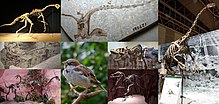
Back Coelurosauria Afrikaans سيلوروصوريات Arabic سيلوروصوريات ARZ Целурозаври Bulgarian Celurosaures Catalan Coelurosauria Czech Coelurosauria German Coelurosauria English Celurosaŭroj Esperanto Coelurosauria Spanish
| Coelurosauria | |
|---|---|

| |
| Classificação científica | |
| Domínio: | Eukaryota |
| Reino: | Animalia |
| Filo: | Chordata |
| Clado: | Dinosauria |
| Clado: | Saurischia |
| Clado: | Theropoda |
| Clado: | Avetheropoda |
| Clado: | Coelurosauria von Huene, 1914 |
| Subgrupos | |

Coelurosauria é um clado de dinossauros terópodes emplumados e que eram predadores. A coelurosauria é um subgrupo de dinossauros de terópodes que inclui Compsognathidae, Tyrannosauroidea, Ornithomimosauria e Maniraptora; Maniraptora inclui aves, o único grupo de dinossauros vivo hoje.[6]
Todos dos dinossauros emplumados descobertos até agora foram celurossauros, a menos que as estruturas vistas em ornitísquios como o Kulindadromeus sejam homólogas às penas. Philip J. Currie considera provável que todos os celurossauros tenham sido emplumados.[7] No passado, Coelurosauria foi usado para se referir a todos os pequenos terópodes, embora esta classificação já tenha sido abolida.
- ↑ Samanthi, A.; Chanthasit, P.; Martin Sander, P. (maio de 2019). «Two new basal coelurosaurian theropod dinosaurs from the Lower Cretaceous Sao Khua Formation of Thailand». Acta Palaeontologica Polonica (em inglês). doi:10.4202/app.00540.2018

- ↑ a b c d Holtz, Thomas R. Jr. (2012) Dinosaurs: The Most Complete, Up-to-Date Encyclopedia for Dinosaur Lovers of All Ages, Winter 2011 Appendix.
- ↑ Holtz, 2000. A new phylogeny of the carnivorous dinosaurs. Gaia. 15, 5-61.
- ↑ Carrano, M.T.; Benson, R.B.J.; Sampson, S.D. (2012). «The phylogeny of Tetanurae (Dinosauria: Theropoda)». Journal of Systematic Palaeontology. 10 (2): 211–300. doi:10.1080/14772019.2011.630927
- ↑ Godefroit, Pascal; Cau, Andrea; Hu, Dong-Yu; Escuillié, François; Wu, Wenhao; Dyke, Gareth (2013). «A Jurassic avialan dinosaur from China resolves the early phylogenetic history of birds». Nature. 498 (7454): 359–362. Bibcode:2013Natur.498..359G. PMID 23719374. doi:10.1038/nature12168
- ↑ Turner, A.H., Makovicky, P.J., and Norell, M.A. 2012. A review of dromaeosaurid systematics and paravian phylogeny. Bulletin of the American Museum of Natural History 371: 1–206.
- ↑ Currie, Philip J. (2005). Dinosaur Provincial Park: A Spectacular Ancient Ecosystem Revealed (em inglês). [S.l.]: Indiana University Press. p. 368. ISBN 978-0-253-34595-0